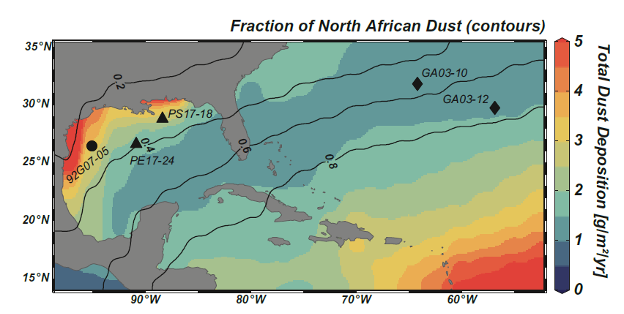North African dust is an important (but not dominant) source of iron to the Gulf of Mexico
Hayes and colleagues (2022, see reference below) have combined new GEOTRACES compliant data from the Gulf of Mexico with prior data from the GA03 North Atlantic Transect to estimate how important North African dust could be as a source of iron to the Gulf of Mexico. While the Gulf of Mexico ecosystem is likely not directly limited by iron, there are significant feedbacks between the supply of fixed nitrogen from cyanobacteria which themselves may be limited by iron (Fe) availability. The Gulf of Mexico is known to receive dust from the Saharan in the summer months, but it is also a marginal sea where rivers, coastal sediments or submarine groundwater discharge may also be significant source of iron and other lithogenic metals. The measured dissolved thorium-232 (232Th) flux from the remote Sargasso Sea (GA03 data), which is directly upwind of the Gulf of Mexico, likely receives 232Th (and by extrapolation iron) mainly from atmospheric dust. Hayes et al. argue that higher dissolved 232Th fluxes measured in the Gulf of Mexico, must mean there are additional marginal sources of the metals in the Gulf and the comparison allows a quantification of how much flux comes from dust rather than other sources. This fraction ends up being a maximum estimate of about 30% of the 232Th and Fe in the Gulf of Mexico comes from dust. It appears dust, rivers, groundwater and sediments likely all play significantly roles in the iron supply to this region and all sources will need to be traced to better predict Fe cycling. These new data are available in the IDP2021.

Figure: Map of a recent model estimate of dust deposition (Kok et al., 2021a, b), with the fraction of that dust coming from North African sources in contours. The black symbols are sites where thorium isotope data is used to quantify the dust-based source of dissolved lithogenic metals such as 232Th or Fe. This figure is modified from Hayes et al. (2022). The new thorium isotope data can help further constrain the model dust estimate.
References:
Hayes, C. T., Shiller, A. M., & Milroy, S. P. (2022). Toward constraining sources of lithogenic metals in the northern Gulf of Mexico. Journal of Geophysical Research: Oceans, 127, e2022JC018523. https://doi.org/10.1029/2022JC018523
Kok et al. (2021a). Improved representation of the global dust cycle using observational constraints on dust properties and abundance. Atmospheric Chemistry and Physics 21, 8127-8167. https://doi.org/10.5194/acp-21-8127-2021
Kok et al. (2021b). Contribution of the world’s main dust source regions to the global cycle of desert dust. Atmospheric Chemistry and Physics 21, 8169-8193. https://doi.org/10.5194/acp-21-8169-2021
